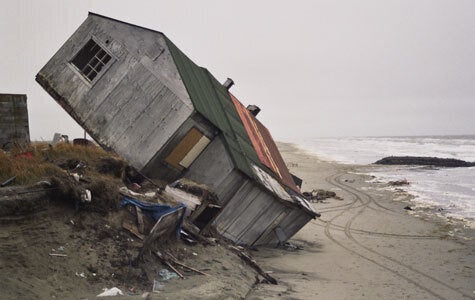
The impact of permafrost thaw due to climate change is missing from the climate modeling in the IPCC's Fifth Assessment reports, yet its emissions could cause global warming to occur 20-30% faster than from fossil fuel emissions alone.
Early last week, the Intergovernmental Panel on Climate Change (IPCC) released its Fifth Assessment Synthesis Report, providing an integrated view of climate change for policymakers and the public alike. The IPCC's Synthesis Report consists of key findings from the three IPCC Working Group reports on the physical science; mitigation; and impacts, adaptions and vulnerability of climate change that were released over the last 13 months.
The Synthesis Report uses some of the strongest language ever printed by the IPCC on the problem of climate change: that atmospheric levels of greenhouse gases (GHGs) are "unprecedented in at least the last 800,000 years," and that "continued emission of GHGs will cause further warming and long-lasting changes in all components of the climate system, increasing the likelihood of severe, pervasive and irreversible impacts for people and ecosystems."
One of the most important reminders raised in the report is that climate change will amplify and create new risks for both human and natural systems. One such risk--which has been largely ignored in the news, the public discourse on climate change, and even in the climate modeling itself for IPCC's Fifth Assessment Report--is the problem of the positive climatic feedback loop that could be caused by permafrost thaw in the Arctic. Despite this omission from the Fifth Assessment's climate modeling, the risk and likelihood of widespread permafrost thaw is of grave importance to climate science, predictions, and policies.
The Problem with Permafrost Thaw
Permafrost is permanently frozen soil that has been frozen for two or more consecutive years, though much of the world's permafrost has been frozen for 30,000-40,000 years. When permafrost thaws, it releases previously stored carbon into the atmosphere, as plant matter within the thawing soil decays.
The problem with permafrost thaw is that 1,400-1,700 gigatons of carbon is estimated to be stored in permafrost worldwide, representing twice as much carbon as currently exists in the atmosphere, and four times the carbon that has been released into the atmosphere from human activities. By the end of the century, scientists in the Permafrost Carbon Network predict that more than 300 billion metric tons of carbon could be released from thawing permafrost, causing global warming to happen at a rate 20-30% faster than from anthropogenic fossil fuel emissions alone.
The Permafrost Carbon Feedback Loop
Permafrost thaw is one of the most dangerous positive feedback loops identified in climate science. Its effects in accelerating planetary warming will make it even more difficult for governments to meet their stated goal of limiting global warming to 2 degrees C above preindustrial levels.
Yet permafrost thaw has not yet been included in the IPCC's climate modeling.
The IPCC's prior report, the Fourth Assessment, published in 2007, cautioned that the Arctic would continue to warm at twice the rate of the rest of the world due to climate change, and predicted that this increased Arctic warming would result in the thaw of permafrost in the northern latitudes.
In the Fifth Assessment reports, the IPCC talks cautiously about the permafrost carbon feedback and its potential consequences, yet the permafrost carbon feedback effect was not incorporated into the future climate models because of low confidence in the quantitative projections of its strength.
In other words, the magnitude of the permafrost carbon feedback remains uncertain, because the scientific knowledge of the phenomenon is so new. For example, scientists do not yet know how much of the carbon released in permafrost thaw will be released as methane, an especially potent heat-trapping gas. The potential for large amounts of methane in the GHG release from permafrost thaw has made the permafrost carbon feedback amplifying effect, according to the New York Times "one of the biggest wild cards in climate science." Thus, scientists and organizations such as the US Department of Energy, have declared understanding the problem of permafrost thaw a major priority.
Climate Policy Implications of Permafrost Thaw
The climactic risks posed by permafrost thaw pose serious risks for humans, both now and in the future. Already, extensive permafrost thaw is forcing climate change adaptation in Alaska, where permafrost thaw is causing houses and other structures to slump, tilt and collapse. 180 villages in Alaska are currently threatened with relocation because of permafrost thaw. At the same time, Alaskan highways, railroads and airstrips are buckling due to permafrost thaw, and the softening soil is interfering with tree root systems, resulting in 'drunken forests.'
How climate change mitigation strategies will react to the problem of permafrost thaw is less clear, though some important immediate steps are being taken. The United Nations Environment Programme and others have argued that a special report needs to be developed and released on permafrost emissions and permafrost carbon feedback, ideally commissioned by the IPCC, to supplement the IPCC's Fifth Assessment.
Until that happens, the emerging knowledge on permafrost thaw means that the climate projections in the Fifth Assessment Summary Report are likely to be overly conservative. This means that reductions of GHGs will need to be even more stringent than suggested by the IPCC to stabilize emissions as a resulting 2 degree C global average temperature increase, making an unfortunately difficult task even harder.